|
A city on water
The first description of the inhabitants on the lagoon comes from
the 6th century AD and was written by the Roman Cassiodoro:
| It appears as though you slide across fields with your
boats because from afar you cannot discern the canals from the
sandbanks... and whilst in other cities you tether animals to
the front of the house, you, with your houses of wicker and
reed, tether your boats. |
Even in those days, the city’s relationship with water was clear.
It is a relationship that has distinguished Venice and her inhabitants
ever since.
|
| 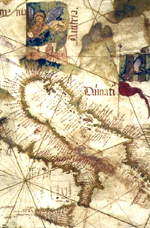
Since the beginning of its history, Venice has lived alongside water
and transformed it into its major sources of income: salt extraction,
fishing and river and maritime commercial traffic.
Over the centuries the city gradually extended its control of the
seas and the ensuing commerce. In fact, the Adriatic was known as
the Gulf of Venice.
|
|
| |
The city’s development brought with it a transformation in the
natural environment: in order to grow, the city needed to make living
space out of the water, orchards, fens, mud and sandbanks. More and
more land was reclaimed thanks to millions of poles driven into the
mud, which then became land to build on. An entire forest of upturned
trees lies at the base of the city. |
| |
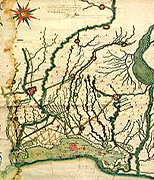
The Venetians have always placed the utmost importance on water
and its regulation: for centuries they have controlled the flow
of rivers, even diverting their outlets to prevent the slow but
progressive flooding of the lagoon. Over the centuries, the flow
of the Brenta, Dese, Sile and Piave rivers has undergone substantial
diversions to allow Venice and its lagoon to survive.
Great attention was given to providing drinking water and its use
was regulated by specially formed magistrates. |
|
A city of rowers
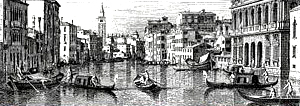 Venice was, and to an extent still is, a city whose principal means
of communication consisted of canals and the traffic was on water.
Venice was, and to an extent still is, a city whose principal means
of communication consisted of canals and the traffic was on water.
Rowing everywhere is a centuries-old form of transport and continues
to survive to this day. Centuries ago, rowing was the ideal training
for mariners working for the Venetian military and civil fleet and
was indispensable for all Venetians.
All the patrician palaces had an entrance opening onto the street
and another more important and magnificent one opening onto the
canal. This is where gondolas were moored, ready to take their masters
and guests around the city.
|
| Venetian-style rowing As they travelled by boat
or ship, Venetians became able seamen and rowers, and were experts
in understanding winds, currents and tides.
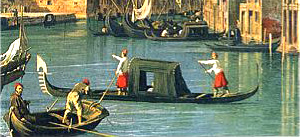 The
surrounding environment forged and conditioned the methods of navigation
and lagoon rowing. The
surrounding environment forged and conditioned the methods of navigation
and lagoon rowing.
The shallow seabed, the winding canals and the presence of sandbanks
called for flat-bottomed boats without a keel. The need for maximum
visibility to locate the most navigable routes led to stand-up rowing,
while the need for using just one oar through the narrow city canals
saw the creation of asymmetric boats that enabled this kind of rowing.
The need to freely move the oar in order to push down on the shallow
seabed or to slip down narrow canals led to the creation of an open
rowlock, the forcola. For the same reasons, the rudder was also
abandoned and substituted by the oar.
|
| Gondoliers 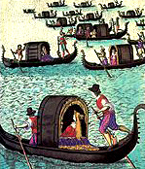 Before
becoming a category exclusively dedicated to tourism, the gondoliers
were the spirit of the city, acting as oar-wielding chauffeurs. Before
becoming a category exclusively dedicated to tourism, the gondoliers
were the spirit of the city, acting as oar-wielding chauffeurs.
They either worked for a patrician family or were employed in public
service and were available to anyone who wanted to reach any part
of the city or lagoon.
This category, which was to become the very symbol of the city,
for centuries constituted the heart of the spectacular regattas
that were increasingly being organised in the city.
|
| Birth of the Regata
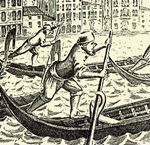 The
regata or rowing race is the most specifically Venetian of local
competitive events and has always exerted considerable appeal for
both Venetians and visitors. The
regata or rowing race is the most specifically Venetian of local
competitive events and has always exerted considerable appeal for
both Venetians and visitors.
The earliest historical evidence relates the races to the celebrations
surrounding the festival of the Marys and date from the second half
of the 13th Century. However, it is probable that similar events
were already popular: Venice was essentially a seafaring city and
ready reserves of expert oarsmen were a prime necessity.
The etymology of the term regata is uncertain. Some trace it to
the word riga (line), others to the verb aurigare
(to compete in a race); and others again to ramigium (rowing);
in any case, the Venetian term regata entered the main
European languages to denote a competitive event raced in boats.
During the Renaissance regate were organized mainly by the Compagnie
della Calza (associations of young noblemen) but from the mid-16th
Century, the Venetian government appointed specific noblemen - called
direttori di regata - to arrange and supervise the races.
|
The competition
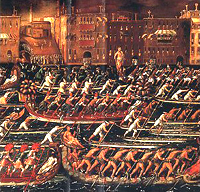 A
typical regatta has always comprised various races using different
kinds of boats and on the occasion of a regatta, the Lagoon in front
of St. Mark’s and the Grand Canal is always teeming with decorated
craft of all kinds, full of passionately keen spectators. A
typical regatta has always comprised various races using different
kinds of boats and on the occasion of a regatta, the Lagoon in front
of St. Mark’s and the Grand Canal is always teeming with decorated
craft of all kinds, full of passionately keen spectators.
To clear the course of the race and to keep order, the regatta used
to be preceded by a fleet of bissone, typical long boats
containing noblemen standing in the bows and armed with bows. Their
job was to pelt the more unruly of the spectators with terracotta
shot. Now the bissone still head the procession before the races,
but they no longer perform a disciplinary function.
The Regata Storica as we know it now, with its commemorative cortege
acting as a prelude to the competitions, was conceived at the end
of the 19th century for the 3rd Biennale d'Arte as a way of offering
another tourist attraction. |
Famous regattas
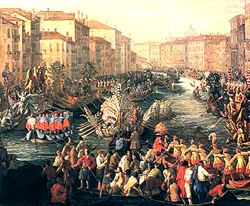
Regate were more common in the past than now and were of two main
types: challenge events between boatmen or gondoliers and regate
grandi, organized as part of the celebrations for some religious
or civic occasion.
For centuries, the regata was also a customary way of marking the
accession of a new Doge and Dogaressa, the appointment of important
public officials such as the Procuratori di San Marco and of welcoming
distinguished visitors to the Serenissima Republic. Dignitaries
honoured in this way included Beatrice d’Este in 1493, Anna
de Foix, Queen of Hungary in 1502, Henry III of France in 1574,
Frederick IX of Denmark in 1709 and the Crown Prince and Princess
of Russia in 1782.
Not infrequently they were also organized and financed by foreign
princes, a famous example being the regata of 1686, arranged at
the wish of Duke Ernest August of Brunswick, a general who had fought
bravely in the service of the Serenissima. |
|